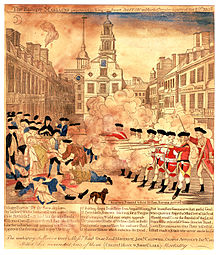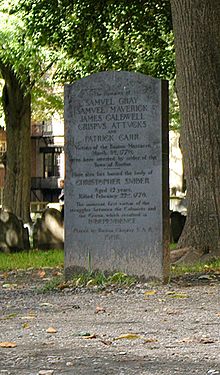Boston Massacre

The Boston Massacre (Engl. Boston Massacre ) was an incident during the American Revolution in British North America on March 5, 1770 in which five civilians by British troops were killed. That for the purpose of propaganda as a " massacre called" schedule is for the groups which followed the independence of the colonies, the beacon and contributed to the outbreak of the American Revolutionary War in.
History and incident that caused it
The colonists were already upset about the Townshend Acts of 1767, which introduced taxation on many everyday items. In order to prevent the outbreak of unrest, British regiments - including the "14th Regiment of Foot" and "29th Regiment of Foot" - were relocated to the city, which was perceived by the residents as an occupying power. After all, in 1768 around two thousand British soldiers were billeted in Boston . Tensions were exacerbated by the fact that mechanics and shopkeepers became unemployed as a result of the boycott of British goods and the soldiers also applied for jobs that were already scarce.
The triggering incident was that an apprentice wig maker named Edward Garrick accused the British officer Captain John Goldfinch of not paying his hairdressing bill. Goldfinch had actually paid his debt that day, but didn't answer the boy. An hour later, when Garrick was still speaking out loudly, the British gate guard at the customs house, Private Hugh White, called the boy over and slapped him. Garrick's pals started yelling at the guard and a British sergeant chased them away. The apprentices returned with others, shouted insults at the guard and threw snowballs and rubbish at them.
White sent a messenger to the main station with a request for assistance. The duty officer, Captain Thomas Preston, sent a corporal and six soldiers, all grenadiers of the 29th Regiment of Foot, and later followed suit himself. The crowd swelled and began throwing stones, sticks, and pieces of ice. A group of seamen and shipyard workers came with large logs of firewood, stood in the front row of the crowd, and stood in front of the soldiers.
In the heat of the moment Private Montgomery was thrown to the ground. He fired his musket into the air and called - as he later admitted to one of his defenders - "fire". All but one of the soldiers then fired their muskets into the crowd. Three American colonists, the rope maker Samuel Gray, the seaman James Caldwell, and the seaman Crispus Attucks , died on the spot. 17-year-old Samuel Maverick was hit by a ricochet and died the next day. Irish immigrant Patrick Carr, 30, died two weeks later. There were also six injured.
In order to keep the peace, the British agreed to withdraw all troops from the city center to Castle William on Castle Island .
Contemporary representations

The event was captured in the picture by a young Boston artist, Henry Pelham, half-brother of the famous portrait painter John Singleton Copley . The Boston silversmith and engraver Paul Revere made an engraving that is closely based on Pelham's picture, which is why this was often ascribed to him. Pelham and Revere added some propaganda details, such as Captain Preston commanding his men to fire and another musket firing from a window of the customs house that was later called "Butcher's Hall". Another deviation was Christian Remick's hand-coloring: the bright blue sky doesn't match the moon or the deep shadows on the left side of the picture. Some copies of the print show a man with two chest wounds and a slightly darker face that matches the description of Attucks, while others do not depict a colored person.
The trial
Captain Preston and the soldiers have been arrested and are due to be tried in Suffolk County . John Adams , Josiah Quincy II and Robert Auchmuty acted as defense attorneys, and Sampson Salter Blowers assisted them with investigations into the jurors. Massachusetts Solicitor General Samuel Quincy and private lawyer Robert Treat Paine , hired by the City of Boston, represented the prosecution. To cool the mood a bit, the trial was delayed for months, which was unusual at the time. The members of the jury all came from other cities.
Preston had its own procedure. He was acquitted because the jury was not convinced that he had given an order to fire. In the second case, the defense had to determine the guilt of each soldier separately, since an unidentified soldier had not fired his weapon and could therefore not be guilty of manslaughter or murder.
The jury therefore acquitted six soldiers in the absence of evidence, and Private Montgomery and Matthew Killroy were found guilty of manslaughter. This was a capital crime at the time, but as first-time offenders, they ended up only being branded on the thumb and not hanged. The jury's decisions suggest that they believed the crowd was threatening the soldiers. Patrick Carr, the fifth victim, supported this view with his deathbed statement to attorney John Adams.
Historical meaning
Samuel Adams and his patriotic colleagues dubbed the deaths for propaganda reasons as "The Boston Massacre". They argued that the importance was not in the small number of deaths, but in the policy of the British to maintain a standing army and use troops to enforce laws they had passed in Parliament against the objections of local law in America .
The public funeral of the first four victims was one of the largest gatherings in North America at the time. From 1771 to 1783, Boston held public memorial services to keep the memory alive. The American Declaration of Independence referred to the massacre in his complaint that they "have billeted large army units with us ... and protect them from punishment through a fake trial for any murder they would commit against the residents of these states".
John Adams, however, called his defense of the soldiers of the Boston Massacre "one of the bravest, most generous, manly, and impartial acts of his life, and one of the best service he has ever done his country," although he too understood the historical significance of the event. by later calling it "the cornerstone of independent America".

The place where the massacre took place is now marked by a circle of cobblestones on the traffic island at the junction of Devonshire and State Streets in front of the Old State House .
literature
- Frederic Kidder: History of the Boston Massacre, March 5, 1770; consisting of the narrative of the town, the trial of the soldiers: and a historical introduction, containing unpublished documents of John Adams, and explanatory notes . Munsell, Albany NY 1870 ( digitized )
- Hermann Wellenreuther: Training and new education. The history of North America from the end of the 17th century to the outbreak of the American Revolution in 1775 , Hamburg 2001, pp. 551–553 (there also references to further literature and research debates).
Web links
- John Holt: An account of a late military massacre at Boston, or the consequences of quartering troops in a populous town, March 12, 1770. New York, 1770 (English, a contemporary account of the massacre from a Bostonian's point of view, one week later the event; reproduced on the Library of Congress website; reproduced from original newspaper pages ).
- Boston Massacre Trial. In: Boston National Historical Park , National Park Service . February 26, 2015(English).
Individual evidence
- ^ Louis Scully: The Boston Massacre 1770. In: WorcestershireRegiment.com. Retrieved March 5, 2020 .
- ^ A b Howard Zinn: A People's History of the United States . Harper Perennial, 2005, pp. 66-67.
